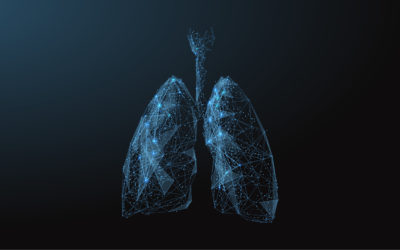Voice biomarkers are a powerful tool in the world of healthcare and clinical research. When a person encounters a medical condition, different organs and parts of the body are impacted including the brain, lungs, heart, muscles, and vocal cords. The healthcare system has long used a standard set of measures to facilitate diagnoses and standards of care. Decades of research document that speech provides valuable information about a person’s health and wellbeing and recent technological progress has produced algorithmic speech measures which help us sensitively detect changes in health status and provide relevant health information. By analyzing speech, voice biomarkers offer unique insights into the human body’s inner workings. Vocal biomarkers are highly effective in diagnosis, monitoring and measuring change in disease, medication titration, and risk prediction.
Speech is a special modality to have in your toolkit because it can simultaneously serve dual purpose. First, speech can be traced to specific neurological changes, because neurological changes can have a direct impact on what you choose to say and how you choose to say it. Secondly, speech also has a direct impact on downstream function, such as your ability to communicate. But what does that do? It impacts your relationships, your quality of life, your ability to hold down a job, your ability to take care of yourself at home. It is our goal at Aural Analytics to provide insight both upstream, into neurological function, and downstream, into activities of daily living.
Definition of voice biomarkers
Voice biomarkers are a type of digital health data. Digital health data are multimodal and high-dimensional. A patient’s health state can be characterized by a multitude of signals including medical imaging, clinical variables, genome sequencing, conversations between clinicians and patients, and continuous signals from wearables, among others. We view speech as a vital sign with both linguistic and acoustic features that unlock health insights that other digital measures are unable to.
Voice biomarkers are the sounds and patterns present in a person’s voice that can be used to identify and track changes in their health status. These biomarkers can be subtle, such as changes in pitch or tone, or more obvious, such as the presence of tremors or other vocal abnormalities. The key is that they provide a non-invasive and easy-to-measure way to monitor a person’s health.
Application of speech biomarkers
So, how are voice biomarkers used? A common application is in clinical trials, where they can be used to measure the effectiveness of a new drug or treatment. By analyzing a patient’s voice before, during, and after treatment, researchers can identify changes in their health that might not be apparent through other means. This can help to speed up the development of new treatments and ensure that they are safe and effective.
Voice biomarkers aren’t just useful in clinical trials. They can also be used in healthcare settings to monitor a patient’s health over time. For example, they can be used to track the progression of diseases like Parkinson’s or ALS, which can affect a person’s voice. By monitoring these changes, doctors can adjust treatment plans and provide better care. Additionally, providers can screen for the onset of new conditions to aid in diagnosis or titrate medications for a condition like Parkinson’s Disease.
How does speech production work?
Speech analysis, in clinical and non-clinical domains, is gaining popularity because it is both easy to collect and also sensitive to all sorts of physiological, psychological, behavioral, functional, and neurological changes. You already know this if you’ve ever had a cold or took an important business call late at night. The challenge with this, as with digital biomarkers more broadly, is in the interpretation. If you treat speech as any old signal, it’s high dimensional, noisy, and context-dependent in a way that’s hard to get consistent signal from. The signal comes from seeing the underlying structure in how language is produced.
There are three main stages of speech production. You first have to conceptualize and call together your cognitive resources – attention, memory, volition with a coherent view of the world to form the idea you’d like to express. Then you formulate your sentence. You find the words associated with that idea; string them together in a grammatically correct order, and do some alchemy to turn those words into neuromuscular commands. And finally you articulate. You use your respiratory system to take a breath, and as you breathe out, you initiate this beautiful and complex choreography of muscles and structures to make your vocal cords vibrate and shape the oral and nasal cavity to produce the sound of your words.
The benefits of voice biomarkers
So, what makes voice biomarkers so powerful? One of the key advantages is that they are non-invasive. Unlike other biomarkers that require blood draws or other invasive procedures, voice biomarkers can be measured simply by recording a person’s voice. This makes them much easier to use and more accessible to patients. They also provide a wealth of information about a person’s health that might not be apparent through other means.
Speech assessments can be repeated from anywhere – in a clinic or at home, supervised or unsupervised. Patients can use their own devices – phone, tablet, or computer – to complete an assessment at their convenience.
Additionally, voice biomarkers are complementary to other digital biomarkers, such as those based on wearables or other sensors. By combining information from multiple sources, researchers and providers can gain a more complete picture of a person’s health.
What conditions do voice biomarkers apply to?
Voice biomarkers can be used across a wide range of conditions. They are particularly useful for neurological and mental health conditions, such as Alzheimer’s, depression, and anxiety. Additionally, they are highly effective in motor conditions such as Parkinson’s Disease and ALS. They can also be used to monitor respiratory conditions, cardiovascular health, and more.
Aural Analytics has a great depth of experience in motor and cognitive disorders. With 15+ motor condition studies and 9+ cognition condition studies, as well as numerous others like oncology and COVID-19. We have one of, if not the largest, number of speech analytics implementations in the industry. We are able to provide expertise that our clients can count on.
Aural Analytics’s speech analytics platform, Speech Vitals, serves as a biomarker relevant for prognosis, tracking, evaluating risk, outcomes, and potentially diagnosis
Voice biomarkers are a powerful tool in the world of healthcare and clinical research. They provide a non-invasive and easy-to-measure way to monitor a person’s health and can be used across a wide range of conditions. By combining information from multiple sources, researchers and doctors can gain a more complete picture of a person’s health, leading to better treatments and outcomes.
Speech Vitals is Aural Analytics’s powerful speech analytics platform. Speech Vitals collects just a few minutes of speech samples from patients via app-based tasks that measure speaking rate, articulatory precision, phonatory duration and many other metrics, depending on the indication or therapeutic area being measured. These metrics serve the purpose of assessing speech-motor conditions. Speech as a vital sign reduces the patient burden, as it is collected through a user-friendly app that can be deployed on any device in-clinic or at home. Speech Vitals is SDK-ready and can be embedded into provider and healthcare system applications, ensuring seamless integration into a clinician’s everyday practice. The metrics generated by the platform are clinically and analytically validated, ensuring results are objective, reliable, and repeatable.
If you are interested in learning more about using voice biomarkers in your next study or in clinic, reach out to Aural Analytics at info@auralanalytics.com.





